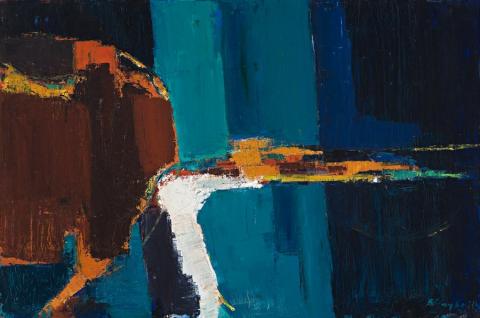THE BAY, 1973
GUY GREY-SMITH
oil and beeswax emulsion on gauze on composition board
121.0 x 180.5 cm
signed and dated lower right: G Grey Smith / (illeg.)
Rudy Komon Gallery, Sydney
Greenhill Galleries, Adelaide
Corporate Collection, Sydney, acquired from the above in 1974
Private collection, Sydney
We are grateful to Andrew Gaynor for his assistance with this catalogue entry
Five Festival Artists of the Adelaide Festival of Arts, Greenhill Galleries, Adelaide, March – April 1974
Guy Grey-Smith's art is very singular, derived from the artist's purposeful independence. Its originality lies in the fact that he painted for personal reasons, believing in the right for 'every individual to say something on his own account'.1 He took particular pleasure in the manipulation of paint as if it were clay, or plaster in the making of a fresco. This was allied to his activities as a potter (his ceramics are in several state galleries including the red earthenware Vase 1963 in the collection of the Art Gallery of New South Wales, Sydney) and his interest in fresco painting, which he had studied in London. 'In terms of pigment,' Grey-Smith said, 'I would like to express my experience of Australia as an Australian who fully appreciates the European cultural traditions from which we have grown, and eventually to attain maturity in a form of art which is universal and at the same time completely self-expressive of our environment.'2 This he achieved in The Bay 1973 and other masterly coastal landscapes of the southwest. His European awareness embraced Cézanne, Matisse, Picasso, Henry Moore, Rouault and Nicolas de Staél. Of the later, Grey-Smith said 'I found de Staél's paintings gave me an avenue of freer individual development - the simplification of form and simpler movement of action, the broader movement of physical action on a canvas.'3
A pioneer of contemporary art in Western Australia, his powerfully emotive images such as Bay 1972 and Karri Forest 1973 celebrate the Australian landscape in intensely felt colour and rich tactile form.4 Map-like, the flatness of the picture plane suggests the aerial view, recalling his time as a pilot during wartime and in peace. The reflective and emotive atmosphere combines with an intriguing ambiguity of pictorial space, endowed with slabs of paint of colour energy - sonorous blues, sulphurous reds, yellows and oranges, vivid whites. Although his work became increasingly abstract, the motif was always retained. The quality of his art was recognized by the Holmes à Courts, whose patronage led to an extensive collection of his work. A splendid example, Breakaway Country, Mount Margaret 1978, (The Holmes à Court Collection, Heytesbury), is similar in approach to our painting. Others include Jasper Bay 1977 from the estate of the late Ann Lewis and Beach 1978, awarded the Gold Coast Art Prize for that year. In recent years collector interest in Grey-Smith has continued to grow, seen in rising values, exhibitions, and scholarly studies. The latest of the latter is Andrew Gaynor's monograph, Guy Grey-Smith: Life Force, to be released by UWAP publishing at the Lawrence Wilson Art Gallery, The University of Western Australia, Perth, this August.
1. Grey-Smith quoted in Thomas, L., The Most noble art of them all, University of Queensland Press, Brisbane, 1976, p.262
2. Grey-Smith quoted in Horton, M. (ed.), Australian Painters of the 70's, Ure Smith, Sydney, 1975, p. 27
3. Grey-Smith quoted in Thomas, op. cit., p. 260
4 . Horton, op. cit., illus. p. 27
DAVID THOMAS
